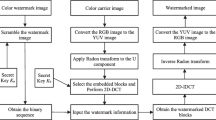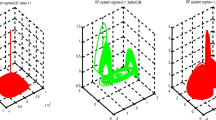Abstract
For digital image copyright protection, watermarking techniques are a promising solution and are of interest to many researchers. In watermarking schemes based on matrix transformation, the embedding element and embedding formula play a very important role in maintaining the quality of a watermark image and the robustness of the watermark. In this paper, a blind image watermarking scheme based on Hessenberg decomposition, where the improvement focuses on the embedding element and embedding formula, is proposed. First, the structure of the Hessenberg factorization is analysed to obtain the most suitable embedding element. Accordingly, this is the first time that the element on the second row and the second column of the upper Hessenberg matrix is selected as an embedding element in a Hessenberg-based image watermarking scheme because of its energy concentration and stability. Second, an improved embedding formula is proposed to address the limitations of previous studies. In the proposed formula, constraint conditions are added to limit the change in all blocks, and a scaling factor is applied to guarantee a trade-off between invisibility and robustness. Here, the scaling factor is carefully calculated by repeating various experiments under different image attacks to achieve an optimal value. Therefore, our proposed embedding formula not only minimizes the modification of the host image after embedding but also helps maintain the robustness of the extracted watermark. Third, to increase the security of the proposed scheme, the watermark image is encoded by the Arnold transform before it is embedded into the host image. The experimental results show that the proposed approach defeats the compared methods in terms of invisibility and execution time. Moreover, the proposed scheme can resist most common attacks when the average normalized correlation value is higher than 0.93 and the extracted watermarks are always clearly recognized.











Similar content being viewed by others
References
Mahto DK, Singh AK (2021) A survey of color image watermarking: State-of-the-art and research directions. Comput Electr Eng 93:107255. https://doi.org/10.1016/j.compeleceng.2021.107255
Jibrin B, Tekanyi A, Sani S (2019) Image watermarking algorithm in frequency domain: a review of technical literature. ATBU J Sci Tech Educ 7(1):257–263
Ray A, Roy S (2020) Recent trends in image watermarking techniques for copyright protection: a survey. Int J Multimed Info Retr 9:249–270. https://doi.org/10.1007/s13735-020-00197-9
Su Q, Wang H, Liu D, Yuan Z, Zhang X (2020) A combined domain watermarking algorithm of color image. Multimed Tools Appl 79:30023–30043. https://doi.org/10.1007/s11042-020-09436-x
Ernawan F, Kabir MN (2020) A block-based RDWT-SVD image watermarking method using human visual system characteristics. The Visual Computer 36(1):19–37
Sun Y, Su Q, Wang H (2022) A blind dual color images watermarking based on quaternion singular value decomposition. Multimed Tools Appl 81:6091–6113. https://doi.org/10.1007/s11042-021-11815-x
Zhang M, Ding W, Li Y, Sun J, Liu Z (2023) Color image watermarking based on a fast structure-preserving algorithm of quaternion singular value decomposition. Signal Process 208(0165–1684):108971. https://doi.org/10.1016/j.sigpro.2023.108971
Hu H-T, Hsu L-Y, Chou H-H (2020) An improved SVD based blind color image watermarking algorithm with mixed modulation incorporated. Inf Sci 519(0020–0255):161–182. https://doi.org/10.1016/j.ins.2020.01.019
Luo A, Gong L, Zhou N (2020) Adaptive and blind watermarking scheme based on optimal SVD blocks selection. Multimed Tools Appl 79:243–261. https://doi.org/10.1007/s11042-019-08074-2
Ahmadi SBB, Zhang G, Rabbani M (2021) An intelligent and blind dual color image watermarking for authentication and copyright protection. Appl Intell 51:1701–1732. https://doi.org/10.1007/s10489-020-01903-0
Wang X, Yao Y, Yu Y (2022) Statistical image watermark decoder by modeling local RDWT difference domain singular values with bivariate weighted Weibull distribution. Appl Intell. https://doi.org/10.1007/s10489-022-03536-x
Hsu LY, Hu HT (2019) A reinforced blind color image watermarking scheme based on Schur decomposition. IEEE Access 7:107438–107452
Sun Y, Su Q, Chen S, Zhang X (2022) A double-color image watermarking algorithm based on quaternion Schur decomposition. Optik 269:169899. https://doi.org/10.1016/j.ijleo.2022.169899
Su Q, Zhang X, Wang G (2019) “An improved watermarking algorithm for color image using Schur Decomposition.” Soft Comput 1–16
Liu D, Su Yuan Z, Q, (2020) A blind color image watermarking scheme with variable steps based on Schur decomposition. Multimed Tools Appl 79:7491–7513. https://doi.org/10.1007/s11042-019-08423-1
Li JY, Zhang CZ (2020) Blind watermarking scheme based on Schur decomposition and non-subsampled contourlet transform. Multimed Tools Appl 79:30007–30021. https://doi.org/10.1007/s11042-020-09389-1
Prabha K, Shatheesh SI (2021) “Lifting Scheme and Schur Decomposition based Robust Watermarking for Copyright Protection.” In: Sheth A, Sinhal A, Shrivastava A, Pandey AK (eds) Intelligent Systems, Algorithms for Intelligent Systems. Springer, Singapore. https://doi.org/10.1007/978-981-16-2248-9-15
Horasan F (2022) A novel image watermarking scheme using ULV decomposition. Optik 259:168958
Muñoz-Ramírez DO, García-Salgado BP, Ponomaryov V, Reyes-Reyes R, Sadovnychiy S, Cruz-Ramos C (2021) A color image watermarking framework for copyright protection of stereo images based on binocular just noticeable difference and LU decomposition. Multimed Tools Appl 80:13707–13734
Hsu CS, Tu SF (2020) Enhancing the robustness of image watermarking against cropping attacks with dual watermarks. Multimed Tools Appl 79:11297–11323. https://doi.org/10.1007/s11042-019-08367-6
Wang H, Su Q (2022) A color image watermarking method combined QR decomposition and spatial domain. Multimed Tools Appl 81(26):37895–37916
Nha PT, Thanh TM, Phong NT (2022) Consideration of a robust watermarking algorithm for color image using improved QR decomposition. Soft Comput 26(11):5069–5093
Dhar PK, Hazra P, Shimamura T (2020) Blind color image watermarking using fan Beam transform and QR decomposition. Symmetry 12(3):486
Li M, Yuan X, Chen H, Li J (2020) Quaternion Discrete Fourier Transform-Based Color Image Watermarking Method Using Quaternion QR Decomposition. IEEE Access 8:72308–72315. https://doi.org/10.1109/ACCESS.2020.2987914
Hsu LY, Hu HT, Chou HH (2022) A high-capacity QRD-based blind color image watermarking algorithm incorporated with AI technologies. Expert Syst Appl 199:117134
Su Q, Liu Y, Liu D, Yuan Z, Ning H (2019) A new watermarking scheme for colour image using QR decomposition and ternary coding. Multimed Tools Appl 78(7):8113–8132
Chen Y, Jia Z-G, Peng Y, Peng Y-X, Zhang D (2021) A new structure-preserving quaternion QR decomposition method for color image blind watermarking. Signal Process 185(0165–1684):108088. https://doi.org/10.1016/j.sigpro.2021.108088
Sejpal S, Borse D (2019) “Comparative Performance Analysis of Color Image watermarking Scheme Using Hessenberg Decomposition and Schur Decomposition.” 2019 5th Int Conf Comput Commun Cont Autom (ICCUBEA) 1–6
Mohammadi M, Nejati F (2020) “Watermarking based on Hessenberg matrix decomposition.” Soft Comput J 9(1):Serial Number 17, 146–157. https://doi.org/10.22052/scj.2021.242811.0
Su Q (2016) Novel blind colour image watermarking technique using Hessenberg decomposition. IET Image Process 10(11):817–829. https://doi.org/10.1049/iet-ipr.2016.0048
Su Q, Chen B (2017) A novel blind color image watermarking using upper Hessenberg matrix. AEU - Int J Electr Commun 78(1434–8411):64–71. https://doi.org/10.1016/j.aeue.2017.05.025
Abodena O, Agoyi M (2018) “Colour image blind watermarking scheme based on fast walsh hadamard transform and hessenberg decomposition.” Stud Inf Cont 27(3):339–348 ISSN: 1220-1766. https://doi.org/10.24846/v27i3y201809
Abduldaim AM, Waleed J, Mazher AN (2020) An Efficient Scheme of Digital Image Watermarking Based on Hessenberg Factorization and DWT. Int Conf Comput Sci Software Eng (CSASE) 2020:180–185. https://doi.org/10.1109/CSASE48920.2020.9142096
Methaq GT, Muhanad YT, Jamal HN, Salama MA (2022) Hessenberg factorization and firework algorithms for optimized data hiding in digital images. J Intell Syst 31(1):440–453. https://doi.org/10.1515/jisys-2022-0029
Wang L, Ji H (2022) A Watermarking Optimization Method Based on Matrix Decomposition and DWT for Multi-Size Images. Electron 11(13):2027. https://doi.org/10.3390/electronics11132027
Begum M, Ferdush J, Uddin MS (2022) A Hybrid robust watermarking system based on discrete cosine transform, discrete wavelet transform, and singular value decomposition. J King Saud University-Comput Inf Sci 34(8):5856–5867
Satish A, Prasad EV, Tejasvi R, Swapna P, Vijayarajan R (2019) “Image Scrambling through Two Level Arnold Transform.” Alliance Int Conf Art Intell Mach Learn (AICAAM)
Masood F, Boulila W, Alsaeedi A, Khan JS, Ahmad J, Khan MA, Rehman SU (2022) A novel image encryption scheme based on Arnold cat map, Newton-Leipnik system and Logistic Gaussian map. Multimed Tools Appl 81(21):30931–30959
University of Granada “Computer Vision Group.” CVG-UGR Image Database. https://decsai.ugr.escvgdbimagenesc512.php. Last accessed 10 December 2022
Rucker F, Britton S, Taylor C (2018) Color and Temporal Frequency Sensitive Eye Growth in Chick. Investig Ophthalmol Vis Sci 59(15):6003–6013. https://doi.org/10.1167/iovs.18-25322
Author information
Authors and Affiliations
Corresponding author
Ethics declarations
Conflict of Interests
All authors declare that there are no conflicts of interest regarding the publication of this paper.
Additional information
Publisher's Note
Springer Nature remains neutral with regard to jurisdictional claims in published maps and institutional affiliations.
Rights and permissions
Springer Nature or its licensor (e.g. a society or other partner) holds exclusive rights to this article under a publishing agreement with the author(s) or other rightsholder(s); author self-archiving of the accepted manuscript version of this article is solely governed by the terms of such publishing agreement and applicable law.
About this article
Cite this article
Nha, P.T., Thanh, T.M. & Phong, N.T. An effective embedding algorithm for blind image watermarking technique based on Hessenberg decomposition. Appl Intell 53, 25467–25489 (2023). https://doi.org/10.1007/s10489-023-04903-y
Accepted:
Published:
Issue Date:
DOI: https://doi.org/10.1007/s10489-023-04903-y




